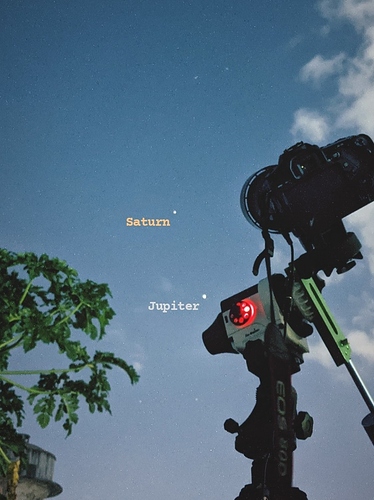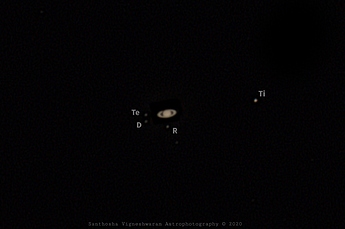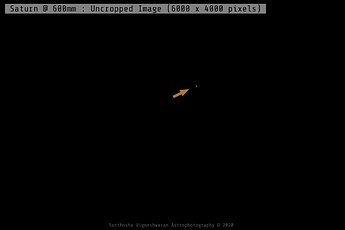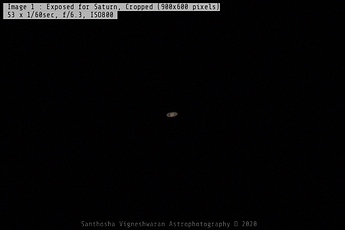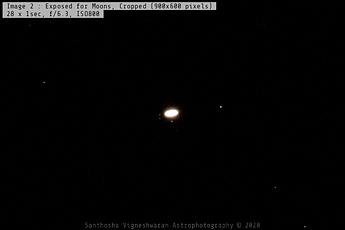As clouds occupied majority of the sky (as usual😓), I was silently observing Saturn & Jupiter with naked eyes…the only things that were visible to me at that time…
Suddenly, I remembered one of my photography Friend’s question : can we image Saturn with a DSLR & Telephoto Lens. We had that discussion long back and I said that it’s highly unlikely…
Since there was nothing else to do, I decided to give it a shot… the sigma 150-600 lens together with my Camera’s 1.6x crop factor gave an effective focal length of 960mm… so why not…
And the result was something I didn’t expect…I was able to resolve Saturn’s rings and 4 of its brightest Moons : Tethys, Dione, Rhea & Titan
We learnt that it’s possible to image Saturn and it’s Satellites with a DSLR + Telephoto lens set up.
Now let’s see How…
- Camera Settings
The first thing we should remember is, we cannot capture both Saturn’s ring system and Moons with single exposure setting due to the difference in their magnitude.
Saturn : 0.46, Titan : 8.5, Rhea : 10.0, Dione : 10.4, Tethys : 10.2 (Lesser the magnitude value, Brighter the object)
My settings for Saturn (refer Image 1 posted below) : 1/60 sec, f/6.3, ISO800
- This exposure is possible without a Star Tracker
- Make sure you reframe the subject after taking few frames… otherwise, it will drift away from the field of view
( I used my tracker to avoid this…i.e, for convenience purpose only)
For Satellites (refer Image 2 posted below) : 1sec, f/6.3, ISO800
- I used my tracker for this exposure. However, I think it’s possible without a tracker also… you may have to increase the ISO and reduce exposure time.
Focal length was set at 600mm for both.
A word of Caution : these were the settings for my observing conditions ( it was quite Hazy & Cloudy that day)
- If the seeing conditions are better, you may have to lower the Exposure time and/or ISO to get a proper exposure
- Pre Processing
- This image is straight out of camera. Can you recognise the planet?May be not!
- My camera records images as 6000 x 4000 pixels. However, Saturn occupies a very small portion in the entire image.
- when cropped down to 900x600 pixels, the Gas Giant becomes visible.
- also, this cropping is necessary for the next step - Stacking
(Software used for cropping : PIPP)
- Stacking
- Stacking is used to increase the signal to Noise ratio of the Image : More images, Better image quality
- Here I have stacked 2 sets of exposures separately
(Software used for Stacking : AutoStakkert)
- Editing
- Edited in Lightrooom Mobile to improve contrast and sharpness
- Combining the 2 exposures :
- used Double Exposure tool in Snapseed to get the final composite image
- My first choice was stacking the Saturn images & satellite images together in AutoStakkert. The result was not satisfactory, so decided to go with Snapseed.
It’s difficult to cover the entire process in this post. I have tried to do my best. If you guys need any info or have an advice to improve the imaging, please do share here… 
#photonsfromthepast #astronomyforeveryone
Canon 80D | Sigma Contemporary 150-600 | Sky-Watcher Star Adventurer
Chennai, 15.10.2020
